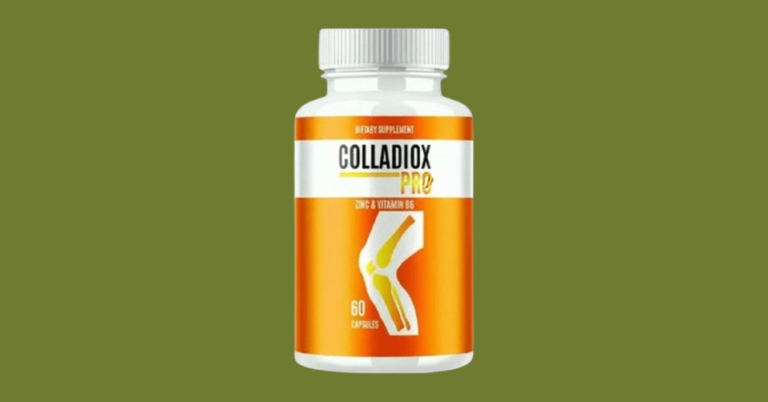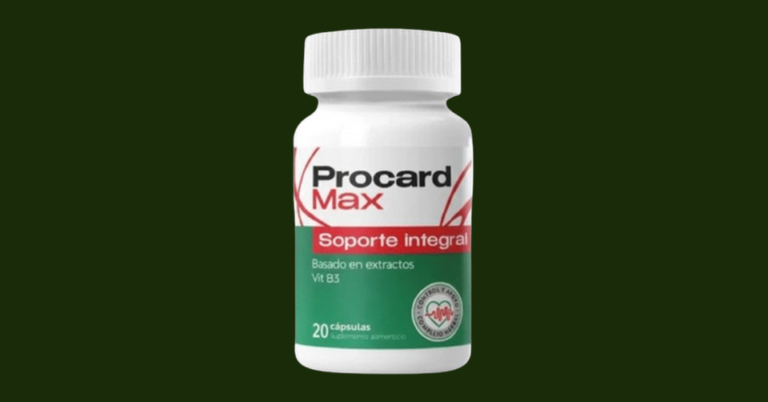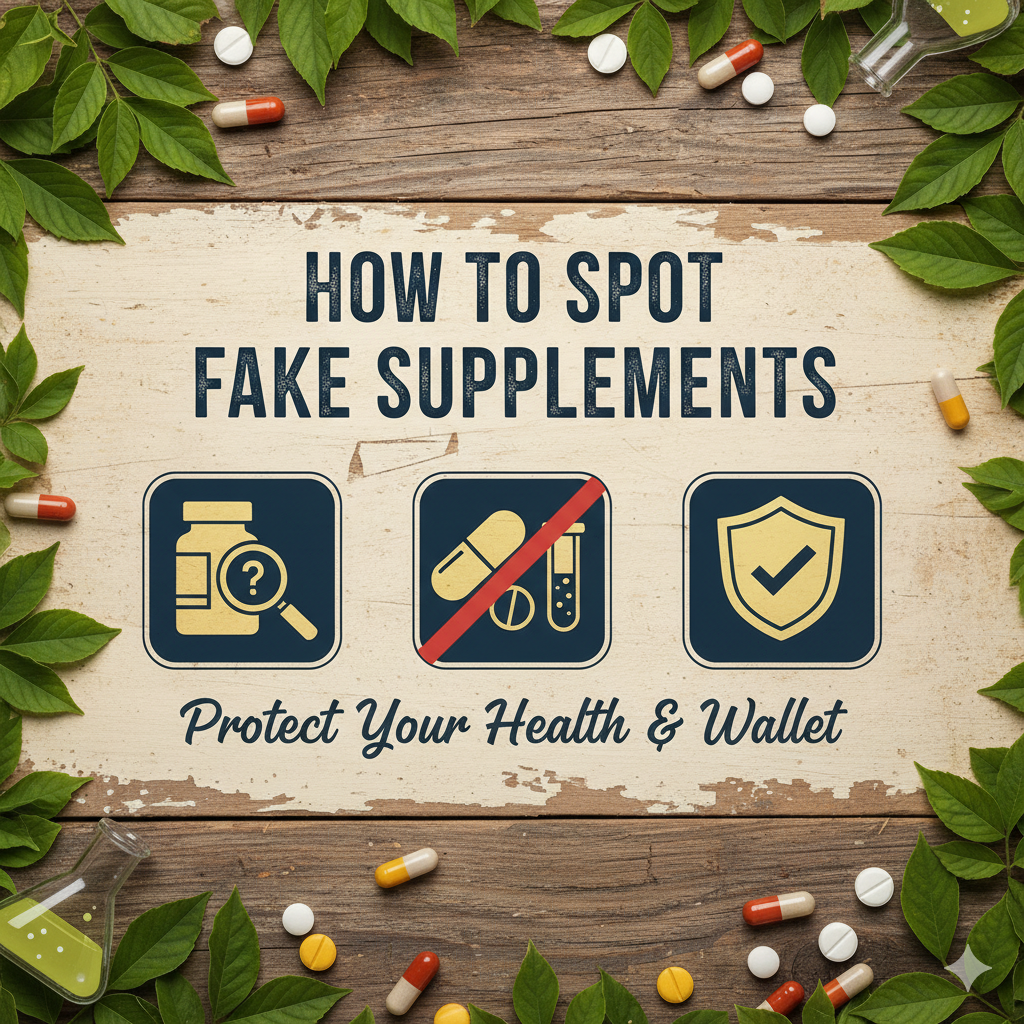
Learning how to spot fake supplements has become essential for health-conscious consumers in today's booming wellness market. The dietary supplement industry generates billions annually, but this growth has attracted counterfeiters who produce fake supplements that not only fail to deliver promised benefits but can actively harm consumers. From protein powders contaminated with heavy metals to vitamins containing dangerous pharmaceutical drugs, fake supplements pose serious health risks that every buyer should understand.
This guide provides practical, actionable information on identifying fake supplements, verifying supplement authenticity, and making informed purchasing decisions that protect both your health and your wallet.
The Dangerous Reality of Counterfeit Supplements
Unlike pharmaceutical drugs, dietary supplements don't require pre-market approval from regulatory bodies in most countries. This regulatory gap creates opportunities for unscrupulous manufacturers to produce counterfeits with impunity.
Recent investigations have uncovered alarming contents in fake supplements: sawdust, talcum powder, undeclared steroids, banned stimulants, heavy metals like lead and mercury, bacterial contamination including E. coli and salmonella, and unlisted allergens causing severe reactions. The health consequences are serious organ damage, hormonal disruption, toxic reactions, allergic emergencies, and ineffective treatment when people rely on fake products instead of proper medical care.
Why counterfeiters target supplements: High profit margins make counterfeiting lucrative, complex supply chains make tracking difficult, online marketplaces provide anonymous selling platforms, and limited regulatory oversight reduces enforcement risks.
How to Spot Fake Supplements: Key Differences
Understanding fake vs real supplements is fundamental to protecting your health. Genuine products have specific characteristics that counterfeiters struggle to replicate perfectly.
Fake vs. Genuine Supplements Comparison
| Feature | Genuine Supplements | Fake Supplements |
|---|---|---|
| Label Quality | Professional printing, sharp text, accurate logos | Blurry text, spelling errors, misaligned graphics |
| Batch Details | Clear batch/lot number, logical dates, full address | Missing or fake batch codes, illogical dates |
| Security Features | Intact tamper-evident seals, quality holograms | Broken seals, poor holograms, no security features |
| Ingredients | Complete list with specific amounts | Vague “proprietary blends,” missing detail |
| Certifications | GMP, NSF, USP, FSSAI clearly printed | Fake or missing certification logos |
| QR/Barcode | Scannable, links to official verification | Non-functional or leads to suspicious sites |
| Physical Quality | Uniform texture, appropriate smell, proper mixing | Strange odors, odd colors, poor dissolution |
| Pricing | Market-rate pricing across authorized retailers | Suspiciously cheap, “too good to be true” |
| Seller | Authorized distributors with verification | Anonymous sellers, unverified third parties |
Essential Verification Methods
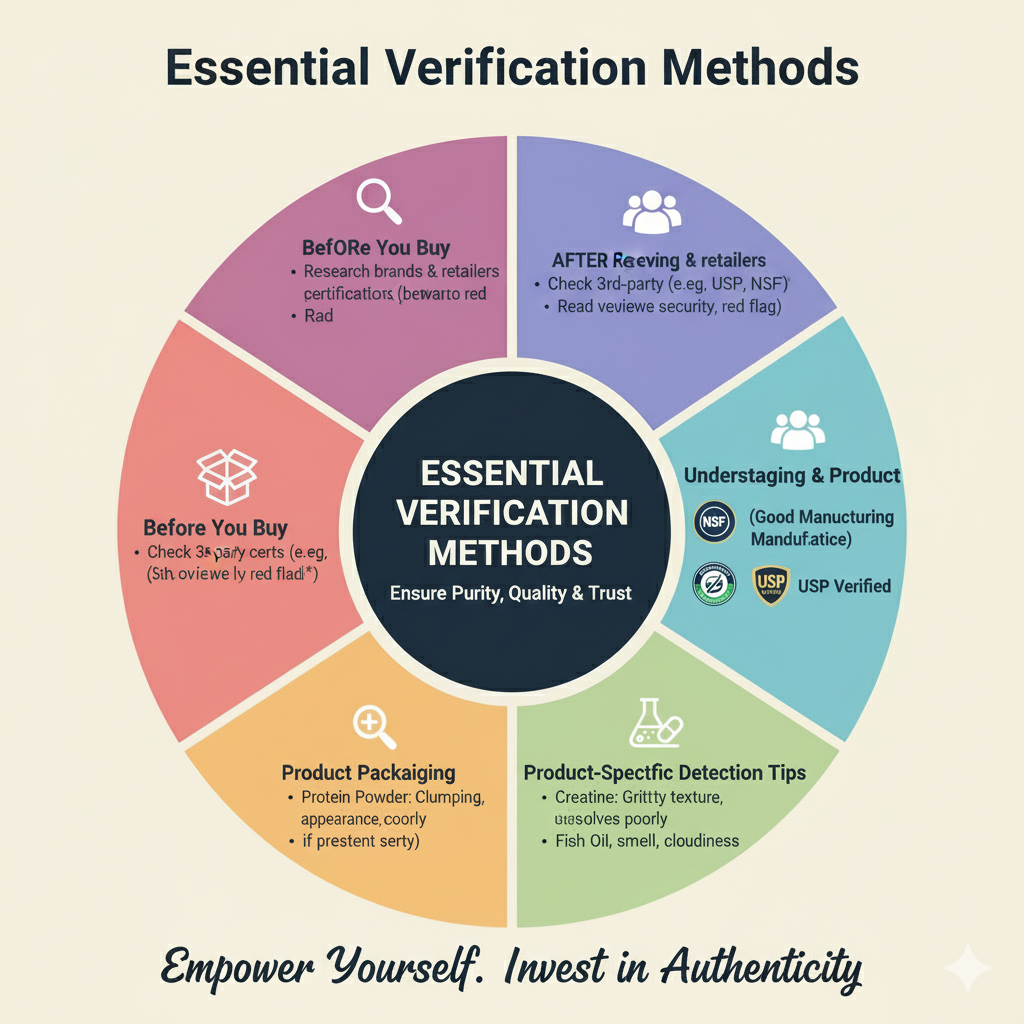
1. Before You Buy
- Research the Brand: Visit the official website and verify professional appearance, complete contact information, transparency about manufacturing, published lab reports, and company history. Legitimate brands have traceable credentials.
- Check Authorized Sellers: Brands maintain lists of authorized retailers on their websites. Verify your seller appears on this list before purchasing. This is especially critical for online marketplaces where third-party sellers mix authentic and fake stock.
- Compare Prices: Note the manufacturer's suggested retail price and compare across multiple authorized retailers. Discounts exceeding 25-30% without clear explanation often indicate counterfeits. Remember: quality ingredients, testing, and proper manufacturing cost money.
- Examine Product Listings: Match product photos to official brand imagery exactly. Check that specifications align with the brand website. Look for complete ingredient lists and reasonable expiration dates. Poor photos or vague descriptions are red flags.
2. After Receiving Your Order
- Inspect Packaging Immediately: Examine seals for tampering, check print quality for clarity and accuracy, verify logos match official versions exactly, and look for spelling or grammatical errors. Check that tamper-evident features are intact and properly placed.
- Verify All Codes: Locate batch/lot numbers and manufacturing/expiry dates. Use your smartphone to scan QR codes they should lead to official brand pages. Input batch numbers on the manufacturer's website to confirm validity. Authentication codes should verify as unused.
- Check Certifications: Look for GMP, NSF, USP, or FSSAI logos (for Indian products). Verify these certifications through the certifying organization's official website. High-quality, clear logos indicate authenticity; pixelated or blurry marks suggest fakes.
- Test Physical Characteristics: For protein powders, check color consistency, texture uniformity, smell appropriateness, mixing quality, and taste. For capsules, verify uniform size/shape/color and proper coating. For liquids, check clarity, consistency, and smell. Genuine products have consistent quality throughout.
- Cross-Reference Ingredients: Visit the brand's official website and compare ingredient lists word-for-word. Verify quantities match exactly. Check allergen warnings are identical. Even minor discrepancies indicate potential counterfeits.
3. Understanding Key Certifications
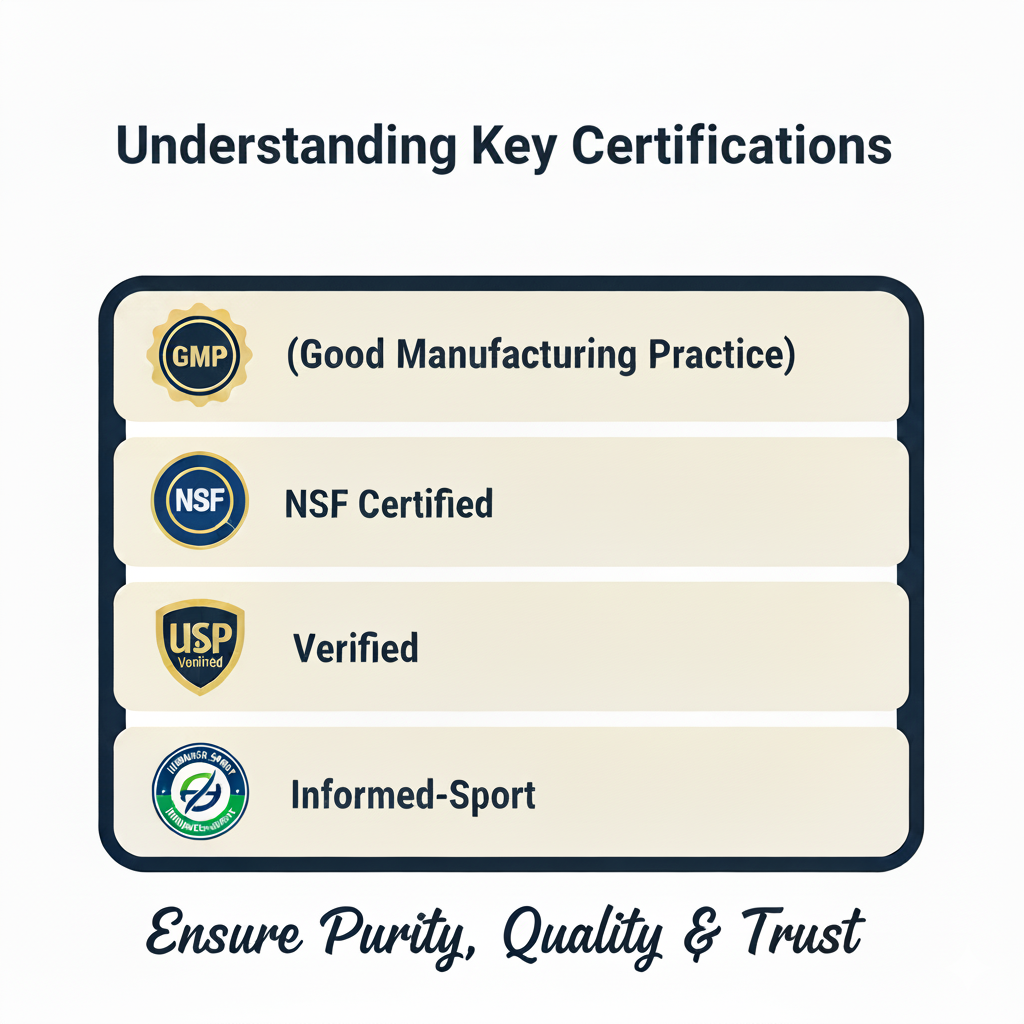
- GMP (Good Manufacturing Practice): Verifies manufacturing facilities follow strict quality control, cleanliness, and process documentation standards. This is the foundation of legitimate supplement manufacturing.
- NSF Certified: Comprehensive testing including label accuracy, contaminant screening, and facility inspection. One of the most respected certifications globally.
- USP Verified: Confirms identity, strength, purity, and quality meet pharmaceutical-grade standards. Especially valuable for vitamins and minerals.
- FSSAI License (India): Mandatory 14-digit number for all supplements sold in India. Verify through the official FSSAI.gov.in portal.
- Informed-Sport: Tests for banned substances on the WADA prohibited list. Critical for competitive athletes.
4. Product-Specific Detection Tips
- Protein Powders: Check for specified protein source types (whey concentrate, isolate, hydrolysate). Perform the mix test genuine whey dissolves smoothly with appropriate foam. Watch for amino acid spiking where cheap amino acids artificially inflate protein content. Look for sports nutrition certifications.
- Herbal Supplements: Verify both common and botanical (Latin) names are listed. Check for standardization information showing active compound percentages. Consider brands using DNA authentication for botanical verification.
- Vitamins and Minerals: Ensure specific forms are listed (e.g., methylcobalamin vs. cyanocobalamin for B12). Different forms have different absorption rates. Verify appropriate USP certification.
5. Platform-Specific Buying Strategies
- Official Brand Websites: Guaranteed authentic but sometimes higher priced. Always verify the URL matches the official domain exactly watch for slight spelling variations indicating fake sites.
- Amazon/Marketplaces: Check the “Sold By” field carefully. Prefer brands' official storefronts. Read reviews mentioning authenticity concerns. Be aware that marketplace inventory can mix authentic and fake stock even from verified sellers.
- Local Retail Chains: Allows physical inspection before purchase. Check packaging, seals, and batch codes in-store. Build relationships with knowledgeable staff.
- Social Media Sellers: Extremely high counterfeit risk. Strongly avoid unless you can absolutely verify authorized distributor status through the brand.
What to Do When You Spot Fake Supplements
Taking immediate action protects your health and warns other consumers.
Action Steps for Detected Counterfeits
| Step | Action | Timeline |
|---|---|---|
| Stop Use | Discontinue consumption immediately | Within minutes |
| Preserve Evidence | Keep product, packaging, and receipts intact | Same day |
| Document | Photograph everything; note symptoms | Same day |
| Contact Brand | Report to manufacturer with evidence | Within 1-2 days |
| Seek Medical Care | If experiencing adverse effects, see doctor | Immediately if symptoms |
| Report Authorities | File complaint with FDA, FSSAI, or local agency | Within 1 week |
| Request Refund | Initiate return through seller or payment provider | Within return window |
| Warn Others | Leave detailed review; share on forums | After brand confirmation |
Building Long-Term Verification Habits
Create a Trusted Brand List: Research and vet brands thoroughly, stick with proven authentic brands, stay informed about brand changes, and join brand communities for insider information.
Establish Reliable Purchase Channels: Identify and consistently use trusted sellers, build relationships with local supplement retailers, bookmark authorized seller lists, and prefer official brand websites when possible.
Stay Informed: Follow supplement industry news, join consumer advocacy groups, participate in online authenticity discussions, and learn about new authentication technologies as they emerge.
Share Knowledge: Help friends and family verify supplements, leave detailed reviews on authentic products, report suspicious sellers, and contribute to community knowledge about supplement authenticity.
Key Takeaways for Spotting Fake Supplements
Mastering how to spot fake supplements requires vigilance and systematic verification:
- Always research brands and verify authorized sellers before buying
- Inspect packaging, codes, certifications, and physical characteristics thoroughly
- Use technology scan QR codes and verify batch numbers online
- Understand certification meanings and verify them independently
- Know product-specific red flags for different supplement types
- Be platform-aware and adjust verification strategies accordingly
- Act immediately if you suspect counterfeits
- Build trusted brand lists and reliable purchasing channels
- Stay informed about counterfeiting tactics and new verification technologies
- Share knowledge to protect the broader consumer community
Conclusion
Learning how to spot fake supplements is crucial for protecting your health in today's complex marketplace. This guide has equipped you with practical strategies for supplement authenticity verification from visual inspection and code verification to understanding certifications and regional requirements.
Understanding the clear differences between fake vs real supplements empowers you to make informed decisions. By mastering counterfeit supplement identification through systematic verification, you take control of your health and refuse to compromise on safety.
Every time you verify a supplement's authenticity checking certifications, scanning codes, examining packaging, and confirming seller legitimacy you're protecting yourself from dangerous products and supporting legitimate manufacturers who invest in quality and transparency.
The proliferation of fake supplements is serious, but informed consumers can navigate it successfully. Armed with this knowledge, you can confidently identify genuine supplements, avoid counterfeits, and make purchasing decisions that truly support your health goals.
Stay vigilant, stay informed, and insist on authenticity. Your health deserves genuine products backed by science, manufactured with care, and sold with integrity. How to verify supplement authenticity isn't just about avoiding fakes it's about taking control of your wellness journey and demanding the quality you deserve.
Sources
Kannal, N.M., Asmathunnisa, N. and Kallimani, J.S., 2024, June. Impacts of Fake Reviews on Dietary Supplements and Healthcare Products in Social Media. In 2024 15th International Conference on Computing Communication and Networking Technologies (ICCCNT) (pp. 1-4). IEEE. Available At : https://ieeexplore.ieee.org/abstract/document/10725718/
Jengathe, M., 2020. A review study on impact of dietary supplement frauds on public health. Int. J. Manag.(IJM), 11, pp.2660-2668. Available At : https://d1wqtxts1xzle7.cloudfront.net/66090452/IJM_11_12_249-libre.pdf?1616582736=&response-content-disposition=inline%3B+filename%3
Ho, H.M.K., Xiong, Z., Wong, H.Y. and Buanz, A., 2022. The era of fake medicines: Investigating counterfeit medicinal products for erectile dysfunction disguised as herbal supplements. International Journal of Pharmaceutics, 617, p.121592. Available At : https://www.sciencedirect.com/science/article/pii/S0378517322001466
Muela-Molina, C., Perelló-Oliver, S. and García-Arranz, A., 2021. False and misleading health-related claims in food supplements on Spanish radio: an analysis from a European Regulatory Framework. Public health nutrition, 24(15), pp.5156-5165. Available At : https://www.sciencedirect.com/science/article/pii/S0378517322001466
Gillingham, K., 1999. Fact or fake? Health fraud and quackery. Health care on the internet, 3(2), pp.33-38. Available At : https://www.tandfonline.com/doi/abs/10.1300/J138v03n02_05
About the Author
Dr. Ervin Downing is a General Practitioner with over 12 years of experience in primary care. He completed his Medical Degree at Harvard Medical School and pursued his Residency in Family Medicine at the prestigious Mayo Clinic. Dr. Downing is currently practicing at Cleveland Clinic, where he focuses on preventative care, chronic disease management, and holistic patient treatment. His approach emphasizes a personalized, compassionate care plan for individuals of all ages.



